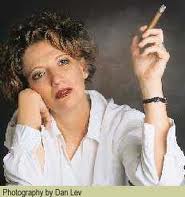 Set in modern Israel, Orly Castel-Bloom’s latest novel Human Parts (translation by Dalyu Bilu, Key Porter Books) follows a troupe of characters around their ordinary lives as the nation struggles with an assortment of blights and curses that almost seem like divine punishments.
Set in modern Israel, Orly Castel-Bloom’s latest novel Human Parts (translation by Dalyu Bilu, Key Porter Books) follows a troupe of characters around their ordinary lives as the nation struggles with an assortment of blights and curses that almost seem like divine punishments.
In Castel-Bloom’s version of Israel, as in real life, there’s a grueling intifadah that inflicts endless terrorist outrages upon an increasingly numbed-out nation. But in her fictional realm, the country is also caught in the grip of a prolonged and unprecedented period of freak rain, hail and snow storms. It must also cope with the Saudi flu, a powerful virus whose victims often end up in hospital or the cemetery. Finally, endemic poverty, racial prejudice, corruption and spiritual malaise also plague the land.
Like personalities in a soap opera, the characters seem so wrapped up in their own personal troubles that they cannot grasp the dire national emergency. As they chase after an illusory success, most of the characters descend instead into a realm of low farce and pathos.
The book presents us with Kati Beit-Halahmi, who lives with her family in a run-down neighbourhood of Lod. Because her husband is out of work and his parents have disinherited him, she scrubs stairwells to feed her children. Invited onto a television talk show about poverty, she shames her husband’s parents before the nation and becomes an instant sensation.
We also meet Liat Dubnov and her half-brother, Adir Bergson, who run a Tel Aviv laundromat. When Liat dies of Saudi flu, the mourners at her funeral are drenched in a sudden cloudburst that fills her grave with water.
Castel-Bloom’s distinctive and colourful troupe also includes Adir’s Ethiopian-Jewish girlfriend, Tasaro, who feels her life’s prayers are answered after she wins a glamour job as the girl who spins the wheel on a television game show; Iris Ventura, a divorced mother struggling with poverty; and Reuven Tekoa, a fictitious Israeli president whose daybook is filled with visits to hospitals, funerals and shiva calls.
When Tekoa arranges to visit Kati Beit-Halahmi, she can’t decide whether to lay out fancy refreshments or emphasize her extreme poverty. However, she’s crushed when he postpones the visit to attend the funeral of a terror victim.
The story unfolds amidst a steady procession of suicide bombings, freak storms, cold snaps and flu deaths. Ordinary Israelis have given up trying to understand their world; public attention is continuously diverted from poverty to terror attacks to the weather to the latest flu statistics. Terror and storm alerts become so commonplace that the government adds more warnings to caution the people not to become apathetic.
During a visit to Toronto, Castel-Bloom, a forty-three-year-old Tel Aviv native, told The CJN that Human Parts is the closest she has come to realism in any of her books. She also explained that it represents the first time she has employed the third-person omniscient narrative voice in her fiction.
“I decided to make the change when I turned forty years old,” she said. “In Judaism, when you are forty years old, you can open the Kabbala. I also gave myself permission to write in the third person, even though I know it’s not an objective point of view. It’s a kind of a lie. But everyone knows that I wrote it, not somebody else.”
The book took her two years to write, she said, during which she had to shift her focus because reality kept intruding into her fictional plan.
“I started before the intifada. I decided to write a social book that would focus on poverty, and then the intifada erupted and invaded the material immediately, so I put it into the background until it eventually expanded and became part of the plot . . . . When I was writing, there was an attack every day or two, and, God forbid, it gave one a kind of inspiration. I wanted to contribute my point of view, to use my capacity as a writer to describe this epoch. History became so invasive that I had to stick with reality.”
A dark and disturbing book, Human Parts paints a highly ironic portrait of Israel that seems equally funny and sad. If it depicts a disintegrating society almost beyond hope or salvation, it also offers a recognizable cry to the heavens for deliverance — suggesting that all hope may not be lost after all. ♦
© 2004






